Trip Logs
The Northwest Passage: From Greenland to the Bering Sea Trip Log: August 26–September 18, 2019
August 26, 2019 | Montreal, Canada
Today, we arrived from the four corners of the world and met at Fairmont The Queen Elizabeth hotel and recuperated from our flights. We spent the day at leisure, shopping for things that we forgot to bring even though our bags were already bulging.
We met for dinner in the evening, where we were welcomed by Phil Otterson, Chairman Emeritus of A&K USA. Julia Evanoff, Operations Manager, Expedition Cruising for A&K, followed suit and welcomed us to our first meeting as a group. She introduced the members of the A&K Expedition Team who would accompany us throughout our journey. The meal gave us our first chance to get to know our fellow guests. Afterward, we returned to our hotel rooms for a good night’s sleep.
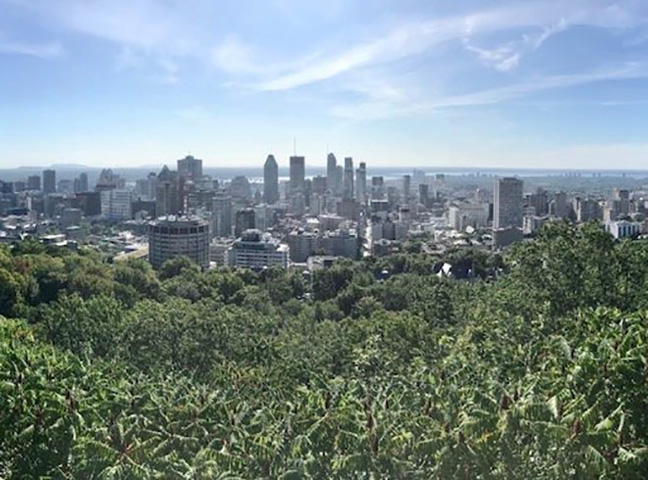
August 27, 2019 | Montreal
Many of us took the opportunity to rest, because we knew that once we boarded the ship for our luxury cruise, sleeping in would be a rare treat. Today, we had our choice of four city tours. Some enjoyed a comprehensive coach tour — which included Old Montreal — or a guided tour of the Notre-Dame Basilica, iconic Mont Royal and the Montreal Olympic Stadium. Still others ventured out on foot. Every tour provided a superb introduction and memorable insights into this fascinating place.
The evening was cut short, as we had to pack and move our luggage out to be collected before we turned in for the night. We would have an early start tomorrow in Greenland.
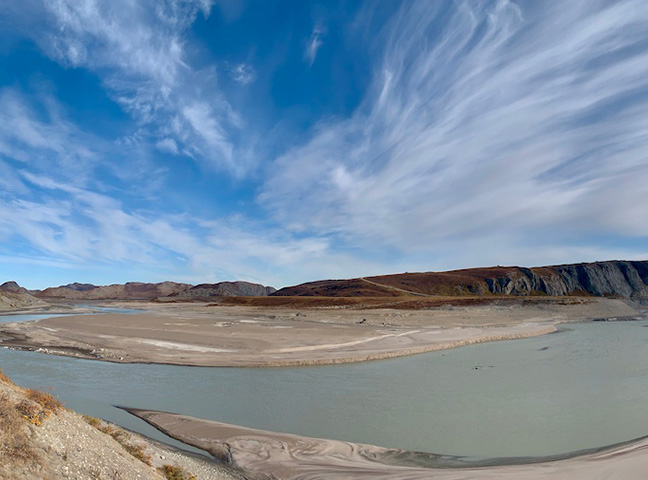
August 28, 2019 | Kangerlussuaq, Greenland
We enjoyed an early breakfast and began boarding the buses for the Montreal airport. Thanks to the A&K Expedition Team, the whole process went swimmingly. After making our way through the airport, we readied ourselves for the three-and-a-half-hour flight ahead. The best parts of the flight were the breathtaking views of Greenland and the Canadian tundra. The breathtaking appeal of Greenland never waned, where mountains plunged into fjords and the seas.
From the airport in Kangerlussuaq, we were transferred to the pier 20 minutes away by bus. Low tide required a careful approach by tenders, which would take us to the beautiful ship, ‘Le Boreal.’ Welcome drinks and snacks awaited everyone on board following our check-in. Baggage was delivered to the cabins by the wonderful crew. We had our mandatory lifeboat drill in the early evening.
Cruise Director Geraldine “JD” Massyn and Expedition Leader Brent Houston gave a warm welcome, and a delicious dinner was served. Most of us retired early as ‘Le Boreal’ steamed down the fjord, toward the open sea en route to Sisimiut.
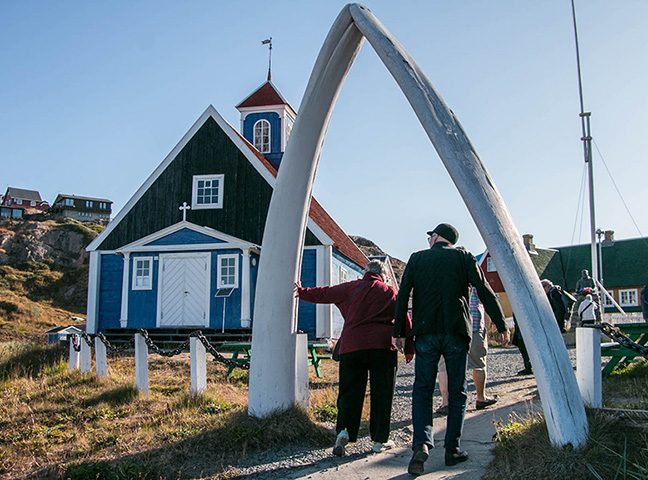
August 29, 2019 | Sisimiut
‘Le Boreal’ arrived early in Sisimiut. With a population of 6,000, it’s the second-largest town in Greenland. The brightly colored homes and buildings, along with the sunshine and perfectly calm sea, created a magical scene. Most of us enjoyed either a walking tour or bus tour, led by local Greenlandic guides. Sod homes — early forms of buildings in this area — could be seen, along with whale jawbone arches, and where working dogs looked more like wolves than anything else.
After lunch, a champion kayaker came alongside the ship to demonstrate his extraordinary skills. Dressed in neoprene and paddling a modern kayak, he calmly rolled and righted his craft in either direction with impunity. Skills such as these are being rapidly lost in the modern world, but they’ve been crucial to the hunting success and survival of the Inuit for countless generations.
Most of the afternoon was spent at leisure, many choosing to take a nap as whales slipped past the vessel. JD and Brent presented the mandatory Association of Arctic Expedition Cruise Operators briefing — where we learned how to safely operate the Zodiacs, rubber inflatable boats commonly used in the Arctic for polar cruises — before the A&K Expedition Team introduced themselves. Geologist and glaciologist Dr. Jason Hicks brought the house down when he shared that he had told his wife-to-be that he rode motorbikes, fired guns and flew airplanes — much to her dismay.
Captain Etienne Garcia’s cocktail party dazzled with all the usual French flair, and he welcomed us aboard and introduced his senior officers. Dinner followed in La Licorne Restaurant on Deck 2. We could not have asked for a finer, more auspicious beginning to this epic adventure.
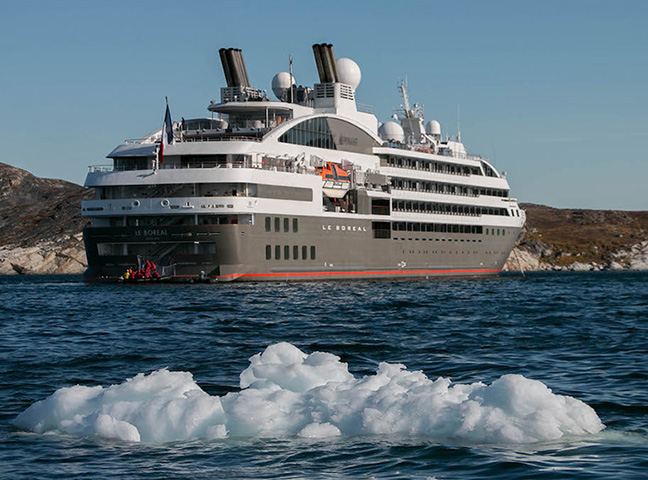
August 30, 2019 | Ilulisat
We enjoyed a calm, 150-nautical-mile run up the west coast of Greenland to Ilulisat. Ilulisat rests in a wide inlet off Baffin Bay, right next to the famous Ilulisat Icefjord, which was first explored by Erik the Red in AD 985 while establishing Norse settlements in Western Greenland. This is one of the fastest-moving and most active glaciers in the world, Sermeq Kujalleq, now a UNESCO World Heritage Site. Most visitors know this area as Disko Bay.
Ilulisat is Greenland’s fourth-largest town and the birthplace of explorer Knudsen Rasmussen. Originally known as Jakobshavn, the history dates back to 1742, first established as a summer mission. It’s now an important fishing town and a center for shrimp processing. During the summer, the fish/shrimp plants operate 24/7, and we saw fishermen landing many sizable fish close to town.
Many of us were up before Brent’s 6 a.m. announcement, and on open decks to witness the massive icebergs and an abundance of smaller growlers. The sun appeared over the horizon in the early morning but scarcely made a difference to the 41-degree Fahrenheit chill, which felt much colder thanks to the stiff breeze. The sights of white and blue ice in the early-morning light painted an indescribable canvas. Humpback whales swam in front of the icebergs, which added to the spectacle.
Half of us were ferried by Zodiac to shore for tours of the town or a hike along a boardwalk to admire the Ilulisat Icefjord. Those who stayed behind were taken on a Zodiac tour close to the massive icebergs. Excitement had reached a fever pitch. The sun shone brightly as we donned our warm clothing and life jackets in preparation for our first Zodiac tour of the expedition. Spanning some 40 miles, the fjord is fed by a mighty glacier from Greenland’s icecap. Loud cracking noises regularly broke the silence, which sounded like artillery fire off in the distance.
Recaps were well presented by naturalist guide and Zodiac driver Richard “Blackjack” Escanilla and climate change specialist Dr. Henry Pollack. Next, Brent went over our plans for tomorrow’s visit among the fjords. The gorgeous weather continued as most retired early after our long, exciting and memorable day around Ilulisat.
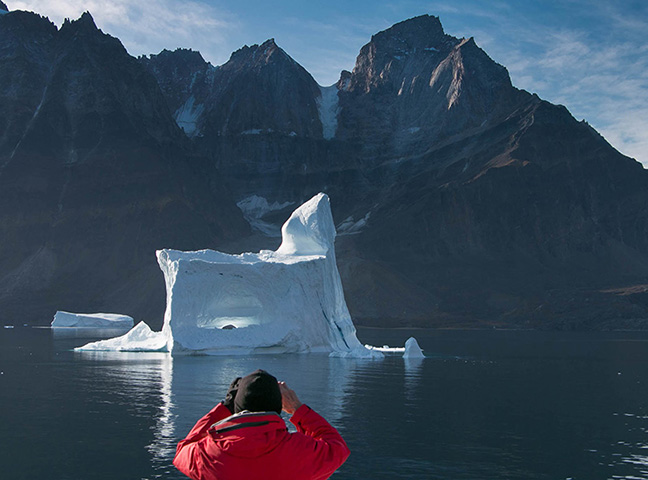
August 31, 2019 | Karrat Island
The dawn brought a fairly choppy sea through which ‘Le Boreal’ sailed with hardly any movement, owing to its impressive stabilizers. Jason presented the morning lecture, who referred to Greenland as a time machine. Records have proven a dramatic increase in carbon dioxide levels, along with a commensurate increase in average temperature. Warming oceans, in turn, absorb less carbon dioxide. The implications of a melting Greenland icecap affect ocean levels across the globe, and everyone found the overwhelming empirical evidence to be sobering.
Jason finished his lecture just as ‘Le Boreal’ entered the magnificent Uummannaq fjord system. A geological wonder teeming with marine life and sheltered by high glaciated mountains, the fjord typically provides favorable weather. In fact, it was considered by many to be the sunniest spot in Greenland.
Today proved no exception, and most of us were out on open decks watching the wonderland slide by on both sides of the ship — where water was punctuated by numerous large icebergs, and steep, fissured slopes plunged dramatically into the depths. In stark contrast to the 1.8-billion-year-old rock formations below, a jet plane soared high overhead. This was certainly Western Greenland at its best.
We landed on Karrat Island, and behemoth icebergs in the bay added to an amazing afternoon. Here, we visited remains of ancient huts fashioned from sod and whale bones. The Thule people (ancestors of the Inuit) frequented this imposing fjord system as a safe haven 500 to 1,000 years ago. En route to the summit, we passed a cemetery and masses of small bones indicating the extent of seal hunting in days gone by. The view over the icebergs and fjords below justified the walk.
A&K could not have asked for a finer start to this incredible voyage of discovery. The weather, sights, people, whales and experiences set the bar sky-high for the days ahead. Photo enrichment coach Michelle Valberg — who was also a Nikon ambassador — presented a wonderful lecture on photography, showcasing some of her exquisite images and explaining how she had taken them. As with many professionals, they make it look and sound so easy. In calm conditions, ‘Le Boreal’ sailed farther north on an ocean studded with a myriad of icebergs.
Archaeologist Margaret Bertulli joined naturalist guide and Zodiac driver Helen Ahern to present some interesting insights before a sumptuous dinner aboard. It was an outstanding day in Greenland, and we very much looked forward to tomorrow.
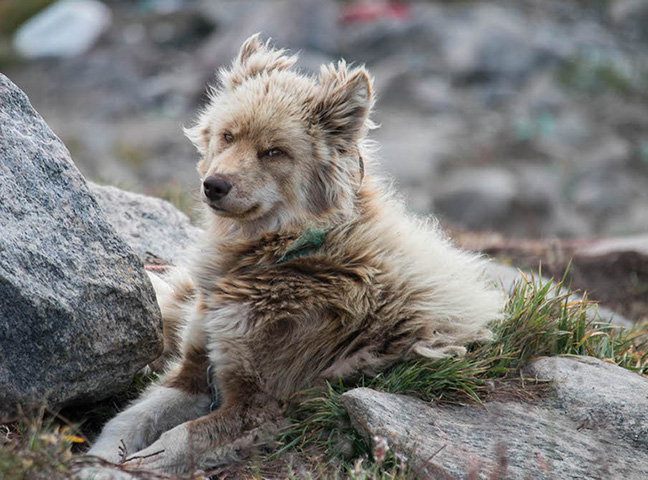
September 1, 2019 | Kullorsuaq
In the morning, ‘Le Boreal’ ran north up the west coast of Greenland on a calm sea, icebergs everywhere. Marine mammals lecturer Matt Messina gave a wonderful talk on whales, focusing on the narwhal, beluga, bowhead and orca, which everyone was hoping to see in these waters. Next, Henry presented “Ice, Water and Climate.” Unfortunately, there was no doubting the prevalence of global warming on an unprecedented scale, which was clearly indicated by changes in ice and water on our planet.
At midday, we approached the remote, traditional village of Kullorsuaq, nestled on Kullorsuaq Island at the southern end of Melville Bay. Named for a nearby mountain that looked oddly like a human thumb, the village expanded significantly after World War II, when many local hunters and fishermen moved there. Today, only 420 inhabitants call this place home. The first migrants arrived here some 4,000 years ago, making Kullorsuaq one of Greenland’s earliest settled areas. The first settlers belonged to the Saqqaq culture, followed by the Dorset culture 3,000 years ago, who spread along the coast of Baffin Bay. Archaeology suggests the Thule people arrived in AD 1200. Interestingly, Danish settlers remained unaware of Kullorsuaq until the end of the 19th century. We also learned that fishing and hunting are the primary occupations of the area.
Captain Garcia had built up a relationship with the villagers over 15 years, and we were privileged to enjoy a walk through the village. By special arrangement, 205 residents came aboard to entertain us with dancing and singing. Young and old filled the theater, and everyone had a truly wonderful time. Scenic Sundowners were enjoyed on the pool deck as everyone waved goodbye to the delightful folks from Kullorsuaq.
Michelle joined musician and philanthropist Mike Stevens for the day’s recaps, focusing on its many human connections. Despite the majestic scenery and wildlife, it is oftentimes the people who are best remembered. Tired but happy, we savored the superb onboard cuisine and retired early.
As American explorer Elisha Kent Kane said of the Arctic back in 1855, “It is more dreamlike and supernatural than a combination of earthly features. It is a landscape such as Milton and Dante might imagine — inorganic, desolate, mysterious.”
One thing was certain: Western Greenland had exceeded everyone’s expectations.
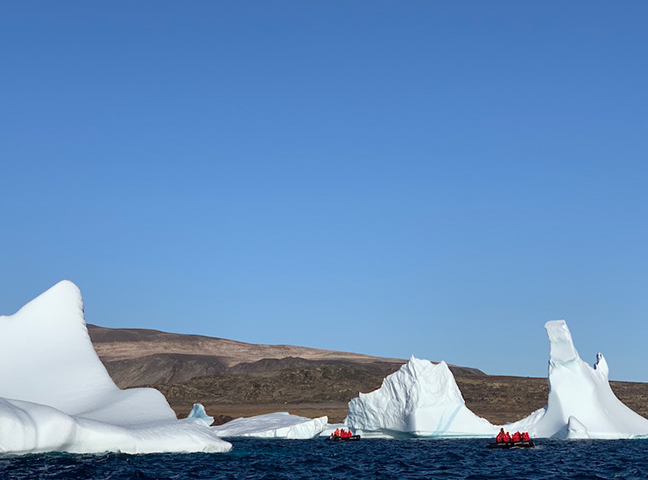
September 2, 2019 | Meteor Bay
Once more, the dawn greeted us with calm seas and wonderful weather. This morning, we entered Meteor Bay, the most northerly point on our expedition. At 76 degrees north, we were only 966 miles from the North Pole. The village of Savissivik took its name from numerous meteorite fragments dating back some 10,000 years. The Cape York meteorite is one of the most famous meteorites in the world, and at 30 tons, it is perhaps the largest meteorite ever to have hit Earth.
In 1818, British Royal Navy officer and polar explorer John Ross found local Inuits using knives and harpoons, some completely made of metal, others with smaller pieces of metal worked into their edges. This gave rise to a mini Iron Age in Greenland 300 years before Icelandic farmers brought iron and agriculture to the south of the island.
Our group was taken out in the Zodiacs to the numerous sparkling icebergs. Julia summed the morning up beautifully, saying “It was like being in a museum.” Still, the forms, colors and grandeur of the ice were too magnificent for words.
At lunch, the chefs prepared a zesty barbecue on the pool deck. Captain Garcia took the ship close to a massive cluster of icebergs, hoping to find a way through. Unfortunately, it wasn’t safe, so a detour was made. Historian Rob Caskie pointed out the Peary Monument visible on the high ground above the icebergs. Peary is the American explorer who infamously whisked the three meteorites off to New York, robbing the Inuit of their invaluable metal. Michelle gave a special lecture titled “Getting Off Automatic,” most of us learning photography tips we had never imagined. Naturalist guide and Zodiac driver Jennifer Clement hosted a popular felting workshop. Afterward, Rob spoke about Roald Amundsen, probably the greatest polar explorer in history.
At recaps, Fred, Margaret, and naturalist guide and Zodiac driver Juan José “JJ” Apestegui Fabrega gave fascinating insights into Greenlandic culture, fishing and culinary delicacies. Margaret displayed images pertaining to the meteorites Peary took to America.
Our adventure in Greenland had been a celebration for the senses. Tonight, we turned our clocks back two hours as we travelled westward, and everyone seemed thrilled at the prospect of getting extra sleep.
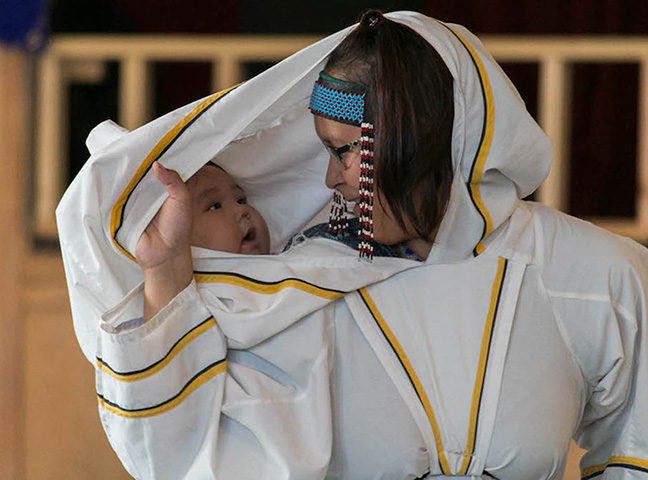
September 3, 2019 | Pond Inlet, Nunavut, Canada
‘Le Boreal’ reached 76 degrees north, our most northerly latitude to date. We slept in this morning, and after a calm voyage across Baffin Bay, we entered Eclipse Sound en route to Canada’s breathtaking Pond Inlet. Worthy of a painting, the scenery was a blend of mountains, glaciers and icebergs. Most of the mountains were capped in snow, and the wind was exceptionally cold.
Arctic culture lecturer Deborah Webster gave an interesting talk on the Inuit Special Constables of the Royal Canadian Mounted Police (RCMP), among them her grandfather and great-grandfather. Next, Mike gave an introductory talk on playing the harmonica. High-quality harmonicas were passed around, and everyone appreciated the opportunity to try them out. A true harmonica maestro, Mike’s authenticity and humanity was evident through his wonderful session.
Lunch was served early in preparation for the customs and immigration procedures arriving into Canada, which also involved vessel inspections. Some of us were required to undergo a face-to-face interview. By the afternoon, we had begun transferring to Pond Inlet for our visit. It was a bumpy ride, and many of us got soaked.
At the Community Center, a lovely demonstration was held regarding Inuit culture, shamanism, singing, dancing and throat singing. Local children participated, and their enthusiasm was infectious. We were also taken on guided walks through the town, much to our delight.
The local co-op store was full of fresh items brought in by airplane, though most supplies are brought into Pond Inlet by ship. During recap, Deborah talked about Inuit culture and Assistant Expedition Leader Adam Walleyn discussed the birds we saw around the ship.
Tomorrow, we would enter Lancaster Sound, a wildlife paradise and the true gateway to the Northwest Passage. That night, we dreamt of seeing belugas, narwhals, polar bears, orcas and various seals.
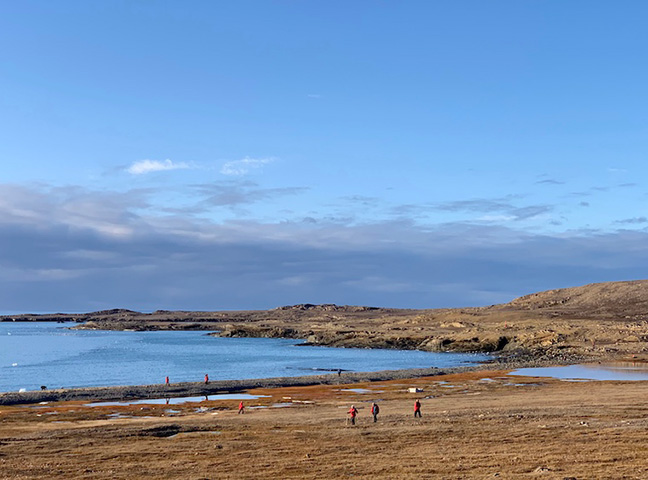
September 4, 2019 | Lancaster Sound & Devon Island
The day began early, exploring Devon Island on the northern shores of Lancaster Sound — named in 1616 by English navigator and explorer William Baffin for Sir James Lancaster, a prominent Elizabethan trader and privateer and one of the three main financial supporters of his explorations. In 1819, English Arctic explorer William Parry got through the sound as far as Melville Island. Coincidentally, the aircraft used for extensive aerial mapping from the 1930s to 1950s was an Avro Lancaster heavy bomber converted for mapping. Inuit, along with their ancestors, have relied on the sound for thousands of years for food, clothing and shelter. Today, residents of three Nunavut communities of Pond Inlet, Arctic Bay and Resolute Bay continue this tradition, relying on its abundant waters for their economic and cultural well-being.
Concerned about the threat to Canada’s sovereignty in the Arctic, RCMP detachments were stationed in places such as Dundas Harbour throughout the 1920s. This tiny outpost was set up in August 1924 as part of a government presence aimed at curbing foreign whaling and other activity. Hudson’s Bay Company leased the post in 1933. The following year, 52 Inuit were relocated from Cape Dorset to Dundas Harbour, but they were returned to the mainland 13 years later. The RCMP detachment was finally closed in 1951 due to ice difficulties. Our group was taken by Zodiac to shore, and a short but rocky walk took us to the old, abandoned RCMP post. In the beautiful morning light, visitors stood in awe of the isolation of this spot. Interred in a small cemetery were two policemen and a baby. Were the policemen murdered, or did they take their own lives? With bear guards situated on the high ground, it was a spectacular landing, the old buildings and light combining for wonderful photo opportunities.
After lunch, Matt caught sight of a polar bear using a powerful scope from the bridge. We poured onto the decks, and you could hear a pin drop as the female led her two cubs across a rocky slope and to the water’s edge. It was a warm day by Arctic standards, and the three seemed pleased to enter the water and cool off. Swimming calmly along the shoreline, among the icebergs, they afforded a unique wildlife experience. Soon, two walruses were spotted on an ice floe.
They were curious-looking creatures with large brown eyes and long white tusks. Captain Garcia skillfully maneuvered ‘Le Boreal’ for a better view without disturbing them. The walrus still anchored to the ice floe seemed to be enjoying its siesta in the warm afternoon sun. Fog descended upon us as Zodiacs were lowered into the water for a cruise in Croker Bay. With safety the primary concern, the Zodiac cruise was canceled. In its place, Rob entertained everyone with an impromptu story in the lounge. Jason followed with a fascinating lecture on the origins of the Atlantic.
Our two Captains gave a wonderful presentation on ice charts, various types of ice, and how ships safely approach ice. To our delight, there was every indication that our ship’s passage would be successful. Dinner ended unexpectedly after Brent announced that hundreds of white beluga whales were in the shallows shedding parasites from their bodies. Later, we watched a video dedicated to Mike’s extraordinary life as a musician and the work he does in communities throughout the Arctic.
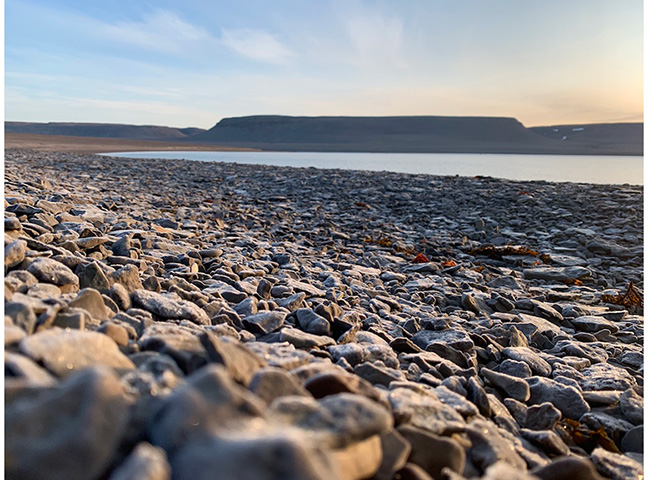
September 5, 2019 | Beechey Island & Barrow Strait
The day began early, with ideal weather at Beechey Island. This tiny island’s steep shores rise to a flat plateau of 732 feet, making it a prominent landmark. ‘Erebus’ and ‘Terror,’ two ships belonging to British Royal Navy officer and Arctic explorer Sir John Franklin, spent the winter of 1845–46 anchored in the bay. During the subsequent searches for Franklin himself, the ships were used as a supply depot and rendezvous point. The protected bay provided a safe refuge throughout the winter, but three of Franklin’s men perished here and were buried on the shore. Just over a mile away is Northumberland House, built on a raised beach by Vice Adm. William Pullen of ‘North Star,’ part of Belcher’s expedition, who lost four of his five ships to the ice from 1852 to 1854.
We were ferried to shore by Zodiac to view the lonely graves of explorers William Braine, John Hartnell and John Torrington. Most made their way to Northumberland House on foot while others arrived by Zodiac. The partial rock walls, old wooden structures, barrel staves and yacht mast reminded us of the stark rigors of the Arctic. A plaque in memory of Joseph-René Bellot of the French Navy — who drowned in 1853 in the same strait that bears his name — keeps watch.
A wonderful tradition of leaving a tube containing guest and crew names began some years ago, and there were now several tubes in the wooden structure behind the ruins. In the morning, an airplane from Resolute Bay buzzed low over our landing site and took a good look at the makeshift airstrip. This is certainly a famous Northwest Passage landmark, and what a privilege it was to treasure it in these conditions.
Back on the ship, Matt gave a wonderfully illustrated talk titled “The Explorers: A History of Art and Adventure.” We learned that Matt was a talented artist and accomplished biologist. He would be teaching art to guests on board.
Lunch was served, and after our delicious meal, Margaret presented an in-depth lecture on the John Franklin Expedition, illuminating the morning visit beautifully. We were all looking forward to visiting King William Island, where the great tragedy occurred in 1848. Unfortunately, conditions became foggy, so we had no choice but to reduce speed. At recap, naturalist guide and Zodiac driver Dr. Frederique “Fred” Olivier explained the differences between Arctic seals and walruses.
The beguiling Bellot Strait and Fort Ross awaited us tomorrow.
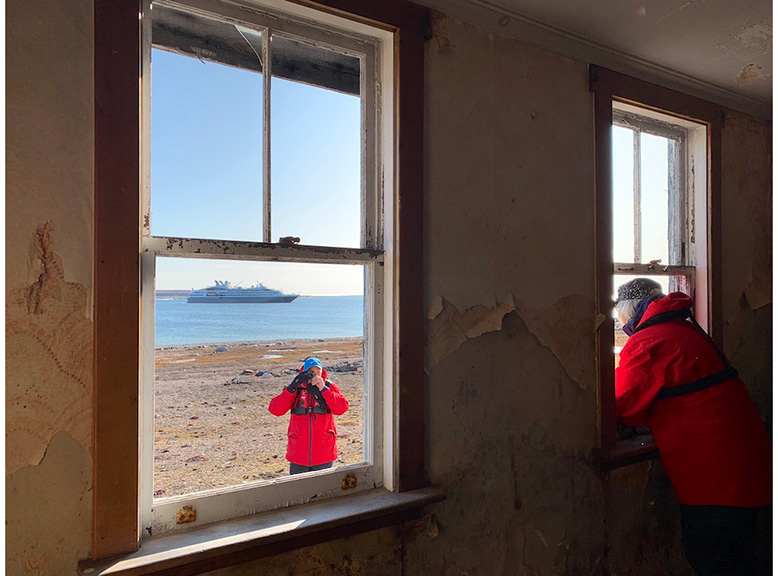
September 6, 2019 | Bellot Strait, Fort Ross & Prince Regent Inlet
The dawn revealed a dense fog, the vessel advancing slowly down Peel Sound. Captain Stéphane Julien of the icebreaker vessel mentioned that the temperature in Prince Regent Inlet was warmer and that the fog may clear. His prediction was correct; the smoke screen dissipated as we advanced through the Bellot Strait against a three-knot current.
In 1937, the strait was first navigated by Captain Scotty Gall aboard ‘Aklavik,’ a small cargo vessel used by the Hudson’s Bay Company to carry supplies to and from its outposts in the High Arctic. The 12-mile waterway connects Prince Regent Inlet with Peel Sound and Franklin Strait. Resembling a fjord, it’s only .6 miles wide at its most narrow point and has steep slopes on either side. In geological terms, the Precambrian rocks (more than 2.5 billion years old) are the core of the landscape, part of the Canadian Shield, and are some of the oldest rocks in the Americas.
We were fortunate enough to see narwhals and a polar bear while transiting the Bellot Strait. Distant blows indicated bowhead whales. Midmorning saw ‘Le Boreal’ anchored off Fort Ross in Prince Regent Inlet at the southeastern tip of Somerset Island. Founded in 1937, it was the last trading post to be established by the Hudson’s Bay Company for the fox pelt trade. Severe ice conditions and difficult access forced the closure of Fort Ross in 1948. Interestingly, buildings are still used by Inuit caribou hunters from Taloyoak. The old store was well equipped, much like a hunting lodge, with a stove for heating and cooking. It was a profound experience, looking around the post as we imagined the difficulties of life here, especially in the wintertime.
Matt spotted several bowhead whales around the ship after lunch. We observed tail-slapping, and even breaching — unusual behavior rarely seen up close. Jason presented his second lecture on the origins of the Atlantic, with glorious sunshine outside the windows. As if this day had not provided enough exhilaration, a group of narwhals could be seen close to the ship, which was, for many, a bucket-list sighting. There was even an Arctic wolf spotted on the slopes above the strait.
Later, Matt and Michelle presented a sublime recap. Soon, we retired for the night, satiated by the Arctic’s magical allure.
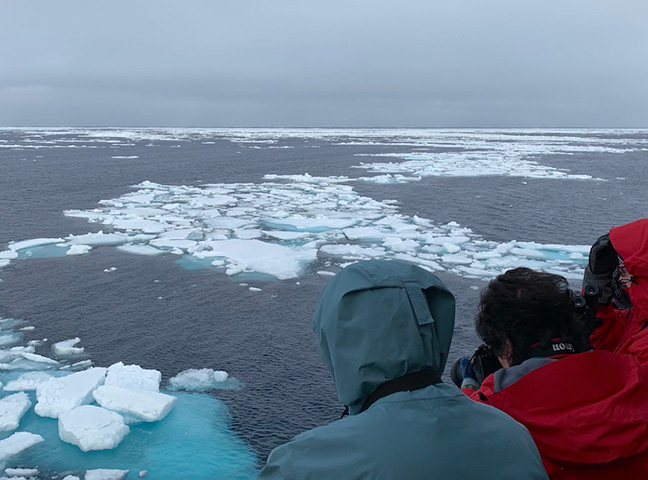
September 7, 2019 | Larsen Sound & James Ross Strait
This morning, ‘Le Boreal’ was caught in thick fog as we steamed southward down Larsen Sound. The sound was named for Canadian Arctic explorer Henry Larsen, who was commander of ‘St. Roch,’ a schooner that resupplied RCMP detachments in the Arctic.
This region is full of hazardous, shallow waterways, which had to be navigated by the explorers, and are the very waters where the historic vessels of the doomed Franklin Expedition ultimately became ruined. Many of the channels are choked with ice throughout the summer, as Franklin discovered in 1847 when his ships, ‘Erebus’ and ‘Terror,’ were beset in consolidated ice at King William Island.
A distant polar bear was spotted, but lying down, it was difficult to spot across the ice. Captain Julien and Captain Garcia did a sterling job of navigating through the ice. Matt gave an insightful talk on Arctic seals. We appreciated the calm and gentle day on board, especially after the amazing activities and viewing opportunities yesterday.
During the afternoon, Michelle shared her stunning photography. Mike presented another fun, engaging harmonica lesson, and then we played an Inuit game with Deborah. We also learned that Mike selflessly created a nonprofit organization called ArtsCan, where music and instruments were taken into northern communities. It was bitterly cold outside; snowflakes descended at regular intervals, and the decks were varnished with sheets of ice.
Rob told stories involving Nansen, Cook and Peary in their quests for the elusive North Pole, which was followed by dinner. The food on board ‘Le Boreal’ had been consistently outstanding, the French flair shining brightly. In such remote locations, the logistics of resupply, cold storage and a variety of options created challenges all their own, but the cuisine was always delicious and beautifully presented. After dinner, Fred shared her experiences filming a 27-day, 341-mile crossing of the Greenland icecap. Entertaining and well illustrated, her journey was, no doubt, a challenging undertaking.
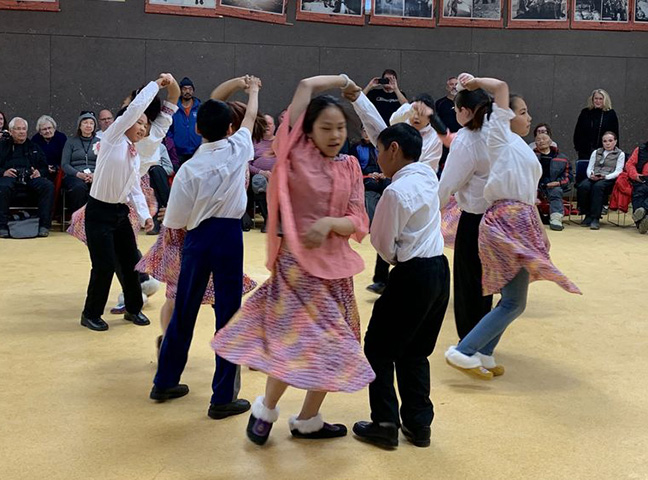
September 8, 2019 | Gjoa Haven
On very calm seas, we arrived at Gjoa Haven on King William Island’s southeast coast. Amundsen dubbed the place “the finest little harbor in the world.” Indeed, the shallow inlet and narrow entrance provided fantastic shelter from the ice. The name remains to this day, and it’s a fine tribute to the sturdy little wooden vessel in which Amundsen first sailed the Northwest Passage so many years ago. To local residents, the community is called Uqsuaqtuuq, meaning “the place of plenty of fat,” a reference to the fattened fish and seals in nearby waters. Interestingly, village elders knew the positions of ‘Erebus’ and ‘Terror,’ but their testimony was always doubted.
Today, Gjoa Haven has a population of 1,200 and still bears the historic significance of playing a key role in polar exploration. Our group was brought ashore by Zodiac as greater white-fronted geese and Canada geese soared overhead. Charming local guides escorted groups of 20 guests to the museum and shop.
A cultural performance took place with local kids square dancing, a drummer and two women singing traditional Inuit songs. Afterward, we took a walk through the village back to the landing site. Some walked the shoreline of the protected harbor up to the Roald Amundsen Marker. We learned that Amundsen’s two years spent here learning from the local Netsilik Inuit left him in great standings, so a sculpture of him had been made in his honor.
‘Le Boreal’ sailed the Simpson Strait, which measures an impressive 40 miles long and two to 10 miles wide. We learned that the strait was named for Scottish Arctic explorer Thomas Simpson, a fur trader for Hudson’s Bay also an Arctic explorer — to complete the discovery and survey of the American continent’s northern shores. They reached this stretch of water in 1839.
Margaret discussed archaeology in the Canadian Arctic, and Henry presented “The New Face of the Arctic.” Matt led an art class appropriate for all levels, with materials provided by A&K.
Most of us chose to eat dinner in the main dining room on Deck 2, and afterward, dancers invited us to join them in the Grand Salon. At 11 p.m., Brent announced that the northern lights were visible. Soon, people were pouring onto the decks to view the mysterious curtains of green light dancing in the Arctic sky.
Michelle stayed up until 3 in the morning capturing these ghostly images, affirming her commitment and dedication to her craft. We couldn’t wait to see these pictures during tomorrow’s recap.

September 9, 2019 | Jenny Lind Island & Queen Maud Gulf
A calm, clear morning found us cruising the Queen Maud Gulf en route to Jenny Lind Island. Close to the area where ‘Erebus’ was discovered in 2014. The Gulf is a wide, shallow basin, where heavy ice overtakes the natural depression for about nine months of the year. We landed on Jenny Lind Island, named after Swedish singer Johanna Maria Lind, who was also known as the “Swedish Nightingale.” Gently sloping beaches and wide sandy tidal flats welcomed the Zodiacs in notably calm waters. We walked onto a low ridge to view snowy owls through a spotting scope. Naturalist guide and Zodiac driver Agustín Ullmann examined and described snowy owl pellets, much to our delight.
Once we landed, we soaked up the fresh, crisp air and returned to ‘Le Boreal’ for lunch. Deborah gave a lecture on Inuit oral tradition and culture, where we learned much about the Inuit, igloouit (single Igloo) and the relatively recent creation of Nunavut in 1999.
Afterward, Brent presented an engaging talk on polar bears. These great mammals have an almost mystic appeal; seeing close-up photos is especially gratifying. The search for sea ice north of Jenny Lind Island was unsuccessful, so we proceeded west on very calm seas. Michelle, Jason and Adam arranged very special recaps on northern lights and snowy owls.
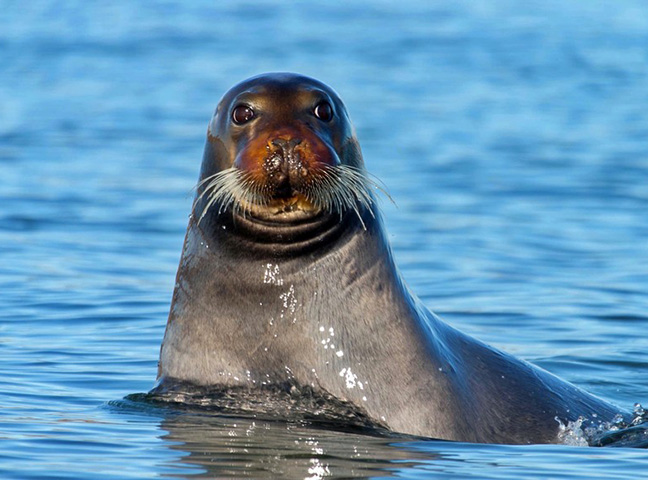
September 10, 2019 | Nakyoktok River, Johansen Bay & Victoria Island
On smooth seas, ‘Le Boreal’ glided west. Jason presented a detailed lecture titled “The Cryosphere and Its Periglacial Landforms.” Naturalists were on deck to assist with bird identification. Guest lecturer Lana Pollack, former head of the U.S. section of the International Joint Commission, gave an interesting talk on the issues regarding the 5,500-mile border between Canada and the U.S. Matters of water, navigation, hydropower, recreation and life required careful discussion to ensure mutual benefit. Julia was on hand to respond to questions regarding future expeditions.
After lunch, we were fortunate enough to land at the mouth of the Nakyoktok River on the southern coast of Victoria Island, the prime habitat for birds in the High Arctic. Not far from an abandoned airstrip, deserted buildings bore witness to the fact that this was an unoccupied area, minus a few roaming hunters. Old buildings used by fishermen and hunters shed a light on the harshness of this environment. The highlight for many were brown bear scratch marks all over one wall of the old wooden hut.
We stepped onto a rocky ridge. These rocks were moved by glaciers and dumped erratically. In balmy conditions and radiant sunshine, some of us were treated to a visit from a curious young bearded seal. Its long whiskers gave it an almost comical appearance, and it swam close by for a long time. Unsurprisingly, everyone seemed reluctant to leave such an idyllic spot.
The recap, hosted by Helen, Agustín and Margaret, was another fine get-together. Then, Brent covered our itinerary for tomorrow’s afternoon in Holman.
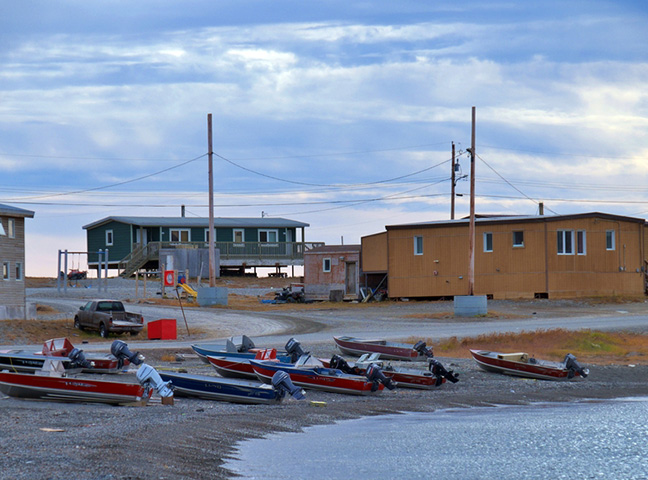
September 11, 2019 | Holman
With a five-foot swell, there was plenty of movement on the ship this morning. The dance instructor led an early morning stretch and tone session, which was held daily. Henry presented a detailed, deeply concerning lecture titled “Confronting Climate Change: What Are the Challenges?” Rob came next, who spoke about the allure of the North and shared tales of polar explorer Salomon Andrée and Scottish Orcadian surgeon John Rae.
The hotel department prepared a wonderful barbecue on Deck 6, which we enjoyed immensely. We spent the afternoon in Ulukhaktok, a small hamlet on the west coast of Victoria Island. The large brown bluff overlooking the Arctic settlement is the source of the slate and copper used to fashion ulus, short-handled knives with crescent-shaped blades. Unique to the High Arctic and central to Inuit culture, these tools are passed down from generation to generation, and it’s believed they contain the wisdom of their ancestors.
Holman was a member of Royal Navy officer Edward Augustus Inglefield’s 1953 expedition aboard ‘Isabel’ in search of Franklin and the apple of Franklin’s eye. Holman Eskimo Co-operative was formed in 1961 to provide income to community residents by producing arts and crafts. This area is famous for its prints, which are a major source of income there. Using lithography, stenciling and stone-cut linocutting, local artists have created prints prized internationally by collectors and museums alike.
The ocean was very choppy, and most of us got wet on the Zodiac ride to shore this afternoon. The locals welcomed us with open arms, accompanied us on guided walks, and provided a fine cultural show of dancing, drumming and singing. It proved to be a fantastic community.
The TV channels provided coverage of the onboard lectures, a virtual tour of the galley area, a video of our expedition thus far, and much more. Everyone was aware of all this and was taking full advantage of this viewing smorgasbord.
Recaps this evening were presented by Russ, Adam and Matt, and Brent went over tomorrow’s romp in the Smoking Hills. Following an exquisite dinner, the dancers lead nightly entertainment in the Grand Salon.

September 12, 2019 | The Smoking Hills & Franklin Bay
The dawn greeted ‘Le Boreal’ with dense fog, so plans quickly changed; we would have lectures this morning and, with any luck, a Zodiac tour after lunch. Jason gave a detailed presentation on the Paleocene-Eocene Thermal Maximum, an abrupt global warming event that occurred at the beginning of the Eocene Epoch over fifty-five million years ago.
Later, Mike led an exciting music class. Mike hoped to have everyone playing a tune by the end of the cruise, but that would prove to be a bridge too far.
Next, Captain Julien talked about his experiences commanding an icebreaker with the Canadian Coast Guard, and overwintering in Franklin Bay (our position today), 11 miles offshore. His ship, ‘Amundsen,’ had been out of Quebec City for 309 days and required refueling despite two million liters of diesel on board. Breaking free from the ice required every ounce of horsepower his ship could muster, but 30 hours of labor consumed 90,000 liters of diesel. Unsurprisingly, there were times throughout his career where he wondered why he had not chosen to be a postman.
Despite the thick fog and only 15 feet of water beneath the keel, Brent organized a Zodiac tour for us to get a closer view of the Smoking Hills. Here, spectacular cliffs of bituminous shale autoignite and burn perpetually. This spontaneous combustion and landing site were first recorded by doctor and geologist John Richardson on Franklin’s second overland expedition to the Arctic in 1826. Interestingly, Richardson noted the acrid fumes, which destroyed ponds inland and even clothing.
Irish Arctic explorer Robert McClure, an onboard investigator in 1851, reported seeing the smoke, believing it was volcanic. We found the tundra’s vegetation changing rapidly as we left the noxious fumes behind.
We waited patiently for the fog to clear. There was good visibility near the shore, and everyone was treated to wonderful views of the smoking vents, cliff faces and sulfurous stains. It’s the only place in the world where this can be viewed and is only accessible by ship, helicopter or floatplane.
Michelle gave a fabulous presentation on photographing wildlife. Her photos were breathtaking; in fact; her bear images are being used on Canadian stamps this year, and rightly so. The recap was a fun affair hosted by Margaret, Mike, Deborah and Jason. Afterward, Brent briefed us on our plans for tomorrow, where we would search for polar bears along the pack-ice edge.
Later that night, we enjoyed a screening of Mamma Mia!
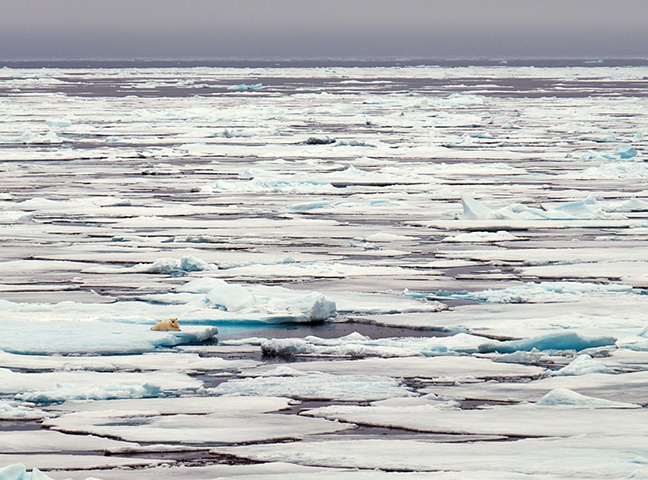
September 13, 2019 | Amundsen Gulf
Friday the 13th may be considered unlucky by some, but not for us. A great night’s rest on calm seas carried us to Amundsen Gulf at the southern extremity of the Beaufort Sea. Matt gave an informative talk on Arctic oceanography. Detailed images and maps assisted us in understanding the complex roles of wind, current, temperature, salinity and depth in polar oceans. We learned that the uninterrupted Antarctic Circumpolar Current is the largest ocean current in the world. During Matt’s lecture, Brent announced over the PA that a polar bear had been sighted on one of the ice floes, and it wasn’t long before we stampeded outside to observe the slumbering giant.
Matt graciously completed his fascinating presentation, and Rob then spoke about the history of the Alaska Highway, which connects the contiguous United States to Alaska across Canada. Rob also shared some personal experiences from his drive along the 1,523-mile route in 1995.
Brent’s efforts had been richly rewarding. Over lunch in the early afternoon, more bears were discovered on the pack ice, with one in particular being especially close to the vessel. The fog played its part, rising and closing in regularly. Afterward, Matt led an art class for those interested.
Beyond the windows, ice punctuated by open leads and pressure ridges had an almost otherworldly look. A rich mass of algae grows in and around the ice, forming the base of the food chain upon which this entire system depends.
Michelle and Fred received entries for the photo competition in three categories: landscape, wildlife and portrait. A documentary was screened concerning climate change and its effects on Inuit life. This was interrupted by an additional announcement over the PA: Another polar bear had been spotted. We moved onto the decks for this leisurely viewing opportunity. The bear rushed toward the ship, apparently unafraid of the metal behemoth. There, it calmly rested on the ice edge, bobbing up and down.
In the early evening, we savored delicious pata negra (Iberian ham) paired with a fine port wine. Recaps began late on account of the polar bear sightings, and Rob shared some insights into Amundsen’s stay at King Point, along with his incredible 500-mile sled ride to Eagle City to telegram news of his Northwest Passage triumph. All in all, it was a marvelous day in the pack ice, and seeing seven bears in a single day was something truly special.

September 14, 2019 | Herschel Island & Yukon Territory
On calm seas, ‘Le Boreal’ proceeded toward Herschel Island, the northernmost point in the Yukon Territory. Henry gave an insightful presentation titled “Antarctica and the Arctic Poles Apart.” There is so much more to understanding popular topics, such as penguins versus polar bears and ocean versus continent.
Jennifer and Michelle led the needle felting group, made up of enthusiastic guests that produced high-quality work. The popular theme being polar beings, the artists did their best to avoid making these northern kings look like sheep. Next, Margaret presented “Arctic Wanderings.” Later, Mike trained us on the harmonica.
Three of us wrote down some words to accompany the melody, which we hoped to fine-tune and present to the rest of the ship. Bowhead whales stayed close to the vessel for a considerable length of time, and it was wonderful to watch a mother whale and her calf surfacing in unison.
Park rangers from Herschel Island came aboard to introduce us to their island and Inuvialuit culture. We boarded Zodiacs and went ashore on Herschel Island, where human influence dates back 1,000 years to the Thule culture. In 1826, Franklin became the first European to visit the island during his second overland expedition surveying the coast. We learned that Franklin named the Island after his friend, the mathematician and chemist John Herschel.
In 1890, a settlement was established, and at the height of the Beaufort Sea whaling period, the number of residents was estimated to be 1,500, making it the largest Yukon community at that time. Herschel Island hosted grand balls, theatrical performances and even sports leagues. Sadly, rising sea levels, violent erosion and permafrost blowout pose imminent threats to the future of the buildings and low areas of this island.
Our group enjoyed a splendid afternoon in gorgeous weather, where we walked around a settlement steeped in history and brimming with artifacts. We met local hunters, who live nine hours away by boat, and searched for caribou. A plane carried the rangers to the 1,000-foot landing strip and took off shortly after our departure, buzzing close to the ship. Then, the A&K Expedition Team took a group photo on the beach. During recap, Margaret, Michelle and Brent offered insights into the voyage. Classical pianist Andrii Vaskevych gave a recital to cap off another staggering day in the Arctic.

September 15, 2019 | Crossing the Beaufort Sea
‘Le Boreal’ headed west on gentle seas. Lana presented “Managing Waters That Cannot Be Managed.” Afterward, naturalists spent time on the open decks answering questions and assisting with wildlife spotting.
Deborah gave a charming talk on Inuit naming practices. She also named Captain Garcia “Atiqtalik,” meaning “polar bear mother,” a moniker affectionately given to men or boys. Later that morning, a pilot from the U.S. Coast Guard boarded our vessel. Many watched as our boat — tiny by comparison — came alongside as the pilot deftly stepped onto the ladder and through the shell door. Apparently, this was a legal requirement now that we were out of Canadian waters and officially in Alaskan waters.
Michelle gave an insightful presentation regarding tips for postproduction editing of photographs. It’s amazing what image-editing software, such as Photoshop or Lightroom, are capable of, and they really take digital photography to a whole new level. Apparently, she had captured 13,000 photos over the course of our voyage.
During afternoon teatime, Deborah told a short Inuit story, then read Akilak’s Adventure, a delightful children’s book she had written. It was wonderful to see everyone sitting and talking together. The Northwest Passage had shined its magic upon us, and great friendships had been quickly forged.
A&K had sponsored sculptures and prints, which were being silently auctioned to raise funds for their philanthropy program. Brent, who was also a polar bear specialist, shared his 25 years of experiences with these extraordinary mammals, along with striking images. At recap, Agustín delighted us with the most amusing spoof, where he compared his photos to Michelle’s.
A concert was held after dinner, with Mike leading the show. Blackjack sang, Captain Julien played, Fred danced, Jennifer played the flute and Agustín sang an emotional song in Spanish that brought everyone to tears with laughter. Naturalist guide and Zodiac driver Cobus Kilian made music using a plastic bag. The talent within the team and on board was staggering, and it made for a fantastic day at sea. We retired late that night, grateful for the incredible memories we were making with A&K.

September 16, 2019 | Crossing the Chukchi Sea
‘Le Boreal’ continued across the Chukchi Sea, approaching the Bering Strait between Alaska and Russia. This sea is named for the Chukchi people, who reside on its shores, traditionally engaged in fishing, whaling and hunting. We learned that the International Dateline crosses the Chukchi Sea from northwest to southeast.
Because we were at sea, lectures formed the bulk of our entertainment. Jason was up first with another brilliant lecture titled “Future Plate Movements: The Next 250 Million Years.” While naturalists were on deck, Jennifer led her last needle-felting class. Margaret then spoke about Fort Conger and the challenges of preserving a historic polar research base in the High Arctic. Fort Conger made a historic appearance in the Nares, Greely and Peary expeditions and is very difficult to reach by ship. Mike led his charges in what would be their last harmonica session before tomorrow evening’s performance.
Lunch was served, and then the Ponant photographers aired the DVD they produced for our voyage, which was available for purchase. It was a wonderful memento of this marvelous journey. Rob spoke about the Iditarod Sled Dog Race from Anchorage to Nome, an epic 1,000-mile journey commemorating the 1925 Great Race of Mercy, where emergency antitoxin had to be swiftly delivered via a coordinated effort of dog-sled relay teams from Nenana, Alaska, to Nome. Although the story is most famous for its happy ending — along with Gunnar Kaasen and his racing dog, Balto, who led the final 600-mile leg of the journey — we also learned about a few of the other heroes who are often overshadowed, musher Leonhard Seppala and his dog, Togo, who covered the most ground and crossed the deadly sea ice of Norton Sound twice.
Afterward, Henry enthralled us with historical tales of Bering, Cook and Vancouver. Captain Garcia hosted the Farewell Cocktail Party and Dinner this evening, and though everyone had an amazing time, we were also sad that our adventure was almost at an end.
September 17, 2019 | Little Diomede Island & the Bering Strait
We arrived in the early morning darkness at Little Diomede, formerly known as Krusenstern Island. It was a must-see destination due to its unique geographical location. It is the smaller of the two Diomede Islands located in the middle of the Bering Strait between the Alaska mainland and Siberia. It’s neighboring island, Big Diomede Island, is 2.4 miles to the west but is part of Russia, and west of the International Dateline. The tiny village is perched at the base of a mountain that juts out of the sea about 135 miles from Nome, Alaska. This island of around 170 inhabitants is one of the few places in Alaska where you can see Russia from shore. The local Ingalikmiut people still maintain a traditional lifestyle of hunting, fishing and egg-gathering.
We were made welcome, and groups of 20 were shown around the village. Later on, a show of dancing and music was held in the local gymnasium that was built by the U.S. government. Boardwalks and steps linked all the buildings and homes, and friendly dogs barked as we passed them. Lonely graves rested above the village on the mountainside. Children were keen to visit the ship, but regrettably, time was against us. Back on board, Captain Garcia opened a bottle of Champagne in spectacular fashion — sabrage-style — and proposed a toast.
Everyone handed in their life jackets, boots and waterproof trousers. JD gave a disembarkation briefing for tomorrow’s arrival in Nome. It was hard to believe we had travelled 4,650 nautical miles since we embarked. What a voyage it had been, with exceptional company, weather and wildlife. The camaraderie and friendships forged were just as important as everything beyond what we saw through the glass.
A fantastic final recap was held, where photography competition winners were announced. Winners bid on the painted chart of our voyage, Mike led his band of harmonica players and Blackjack presented a slide show he had painstakingly created. JD thanked the team for their contribution, and Phil presented Captain Julien with an A&K parka — a rather appropriate gift, all things considered.
In the evening, a large barge-type vessel came alongside ‘Le Boreal’ and bunkered the ship with 300,000 liters of diesel fuel for our onward journey. Words fail miserably to adequately describe this journey we had together through the High Arctic and famed Northwest Passage. We are some of the privileged few to have sailed this famed route. And to have experienced this with A&K elevated our already unforgettable Arctic cruise to sublime levels. Without a doubt, our journey will remain etched in the minds of all who participated — forever.
 The Americas
The Americas Europe, Middle East and Africa
Europe, Middle East and Africa Australia, NZ and Asia
Australia, NZ and Asia

















































































































































































































































































































































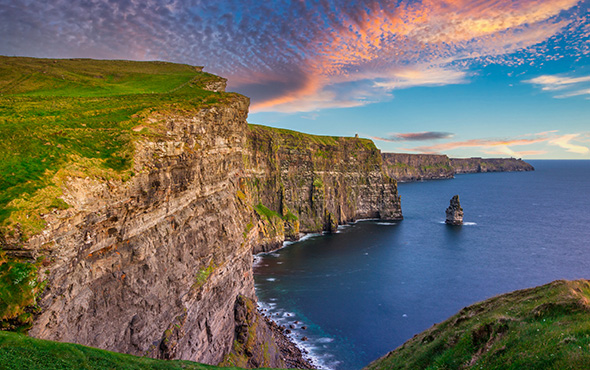




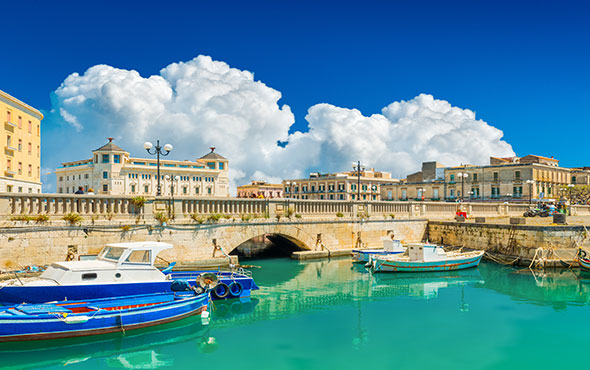



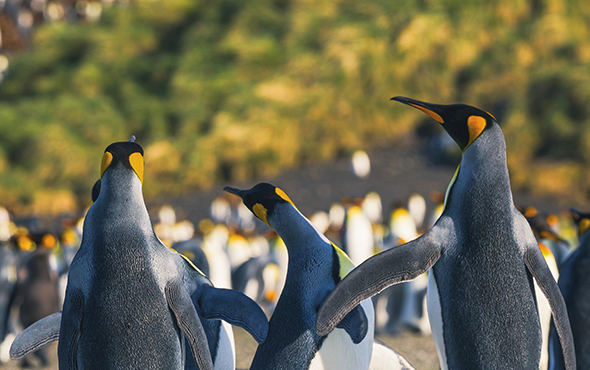
 The Americas
The Americas
 Europe, Middle East and Africa
Europe, Middle East and Africa Australia, NZ and Asia
Australia, NZ and Asia